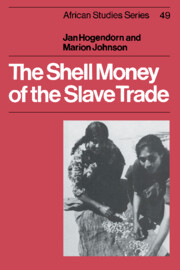Book contents
- Frontmatter
- Contents
- Maps
- Tables and chart
- Preface
- Introduction
- 1 The cowrie
- 2 The Maldive Islands
- 3 The Portuguese domination
- 4 The Dutch and English enter the trade (seventeenth century)
- 5 Prosperity for the cowrie commerce (eighteenth century)
- 6 Boom and slump for the cowrie trade (nineteenth century)
- 7 Collection, transport and distribution
- 8 Cowries in Africa
- 9 The cowrie as money: transport costs, values and inflation
- 10 The last of the cowrie
- Notes
- Bibliogaphy
- Index
6 - Boom and slump for the cowrie trade (nineteenth century)
Published online by Cambridge University Press: 12 October 2009
- Frontmatter
- Contents
- Maps
- Tables and chart
- Preface
- Introduction
- 1 The cowrie
- 2 The Maldive Islands
- 3 The Portuguese domination
- 4 The Dutch and English enter the trade (seventeenth century)
- 5 Prosperity for the cowrie commerce (eighteenth century)
- 6 Boom and slump for the cowrie trade (nineteenth century)
- 7 Collection, transport and distribution
- 8 Cowries in Africa
- 9 The cowrie as money: transport costs, values and inflation
- 10 The last of the cowrie
- Notes
- Bibliogaphy
- Index
Summary
The cowrie trade went through a cycle of boom and slump, boom and slump, in the nineteenth century. In 1800 the British had achieved almost complete ascendancy in shipments to West Africa, with the Dutch and French now entirely out of the running. This led to a surge in British shell exports in the first eight years of the century, to an annual average of over 68 tonnes compared to the 24-tonne average for the eight years 1791–1798. These figures are substantially above the British annual average for the eighteenth century to 1790 (though only some 55% of the 125-tonne annual mean for 1700–1790 when Dutch sales are included). As before, the auctions of the East India Company remained the major mart for putting the shells in the hands of merchants trading to Africa.
Depression loomed, however, with a twofold cause. After decades of anti-slavery agitation, the British banned the slave trade in 1807. Slaves had been, of course, the major means of paying for shell imports to Africa. Simultaneously, British monetary policy in India was causing a rapid slackening in the demand for cowries in its remaining markets, Bengal and Orissa. Together, these events wrought temporary ruin for the shell trade, and presumably brought an economic slump to the Maldives, mitigated only by the maintenance of its coir exports.
The first cause of the great cowrie depression, abolition of the slave trade, demonstrated vividly the direct link between the export of blacks and shell imports to West Africa.
- Type
- Chapter
- Information
- The Shell Money of the Slave Trade , pp. 64 - 79Publisher: Cambridge University PressPrint publication year: 1986



